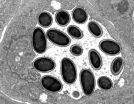(Press-News.org) In the first study to look at would-be diseases carried by New York City rats, scientists at the Center for Infection and Immunity at Columbia University's Mailman School of Public Health identified bacterial pathogens, including E. coli, Salmonella, and C. difficile, that cause mild to life-threatening gastroenteritis in people; Seoul hantavirus, which causes Ebola-like hemorrhagic fever and kidney failure in humans; and the closest relative to human hepatitis C. Results appear in the journal mBio.
The researchers trapped 133 Norway rats at 5 sites in New York City, focusing on rats trapped inside residential buildings. In the lab, targeted molecular assays confirmed the presence of 15 of the 20 bacterial and protozoan pathogens they looked for and one virus: Seoul hantavirus was present in eight rats. It is the first time the virus has been documented in New York City, and genetic clues suggest that it may be a recent arrival. Human infection has been associated with multiple cases of hemorrhagic fever with renal syndrome, and chronic renal disease in Maryland and Los Angeles. The virus has also been implicated in cases of hypertension.
It is unknown how often humans become sick from rats and what viruses cross over, but according to first author Cadhla Firth, PhD, transmission could happen in any number of ways. Rats leave behind quantities of the pathogens in saliva, urine, or feces that people or their pets come in contact with.
"New Yorkers are constantly exposed to rats and the pathogens they carry, perhaps more than any other animal," explains Dr. Firth, who conducted the study as a research scientist at Columbia's Center for Infection and Immunity. "Despite this, we know very little about the impact they have on human health. "
Animal Model for Hepatitis C
High throughput screening methods developed by the Center for Infection and Immunity employed to test for the presence of known and unknown microbes identified 18 novel viruses, including two rat hepaciviruses dubbed NrHV-1 and NrHV-2. Although these are not the closest relatives to human hepatitis C discovered, the identification of these viruses in a species commonly used in medical research is extremely important, the researchers say. Notably, the two viruses replicate naturally in the animal's liver, which suggests that their lifecycle is similar to human hepatitis C virus.
"With the loss of the chimpanzee model for hepatitis C, the availability of an animal model that has fidelity to the human model is extremely important to efforts to develop drugs and vaccines," says senior author W. Ian Lipkin, MD, John Snow Professor of Epidemiology and director of the Center for Infection and Immunity at Columbia's Mailman School, who has discovered more than 600 viruses over the course of his career.
An estimated 3.2 million Americans and 130-150 million people worldwide have a chronic hepatitis C virus infection, which can lead to liver cancer and cirrhosis.
Rats as Sentinels for Human Disease
The study developed out of conversations between Dr. Lipkin and the late Joshua Lederberg, a molecular biologist and Nobel laureate. The two scientists wanted to study rats in New York City to have a point of comparison in case a pathogen crossed over and caused a human outbreak. "It started as a biodefense initiative," says Dr. Lipkin. "If we are to pick up something that is a novel threat to public health, we have to know the baseline microflora."
Dr. Lipkin continues: "Rats are sentinels for human disease. They're all over the city; uptown, downtown, underground. Everywhere they go, they collect microbes and amplify them. And because these animals live close to people, there is ample opportunity for exchange."
Continual monitoring of the rat population is needed along with studies in people to understand how the animals and the microbes they carry make us sick, Dr. Lipkin notes. With modern disease surveillance methods, a repeat of the rat-borne Black Death, which killed as much as 60 percent of the population of 14th Century Europe, or a similar outbreak need not happen.
INFORMATION:
Dr. Firth is currently a research scientist at CSIRO in Geelong, Australia. Co-authors include Meera Bhat, Simon H. Williams, Juliette M. Conte, James Ng, Joel Garcia, Nishit P. Bhuva, Bohyun Lee, Xiaoyu Che, and Phenix-Lan Quan at the Center for Infection and Immunity; Matthew A. Firth at Memorial Sloan-Kettering Cancer Center; Matthew J. Frye at Cornell University; and Peter Simmonds at the University of Edinburgh.
About Columbia University's Mailman School of Public Health
Founded in 1922, Columbia University's Mailman School of Public Health pursues an agenda of research, education, and service to address the critical and complex public health issues affecting New Yorkers, the nation and the world. The Mailman School is the third largest recipient of NIH grants among schools of public health. Its over 450 multi-disciplinary faculty members work in more than 100 countries around the world, addressing such issues as preventing infectious and chronic diseases, environmental health, maternal and child health, health policy, climate change & health, and public health preparedness. It is a leader in public health education with over 1,300 graduate students from more than 40 nations pursuing a variety of master's and doctoral degree programs. The Mailman School is also home to numerous world-renowned research centers including ICAP (formerly the International Center for AIDS Care and Treatment Programs) and the Center for Infection and Immunity. For more information, please visit http://www.mailman.columbia.edu.
Cracking the genetic code of a common disease affecting grape production could improve vineyard management and help protect the multibillion-dollar industry that includes raisins, juice, jam/jelly, fresh grapes, grape-seed extract and oil, vinegar and wine.
A Rochester Institute of Technology scientist and an RIT alumnus are close to completing the genetic blueprint, or microbiome, of grape crown gall tumor disease—the bane of vineyards worldwide. Their study focuses on 16 grape varieties, including Cabernet Sauvignon and Riesling, from vineyards in the New York ...
What would happen to all those millions of Snickers fans if their favorite chocolate bar was temporarily out of stock? Would they wait for it to be available again or would they quickly switch allegiance to Milky Way or Kit Kat? According to a new study in the Journal of Consumer Research, when you can't get your favorite product, you'll quickly forget about it if you can find a good replacement.
"We studied situations in which products are temporarily unavailable. We found that desire for a product depends on the amount of time that has passed since a consumer was able ...
AUGUSTA, Ga. – One of the first-known oncogenes has a protein partner that helps breast cancer proliferate and when it's blocked, so is the cancer, scientists report.
The gene ErbB2, commonly called HER2, is highly expressed in about 25 percent of breast cancers. Scientists have now found the protein Erbin, thought to be an anti-tumor factor, also is highly expressed in these cancers and essential to ErbB2's support of breast cancer.
When scientists interfere with the interaction between the two in mice, it inhibits tumor development and the usual spread to the ...
Imagine you're dining out with a friend who insists on sharing some chocolate cake for dessert. Since the decision has already been made for you, you gladly join in without feeling any regret. According to a new study in the Journal of Consumer Research, consumers are happier when someone else decides they can indulge in dessert or other guilty pleasures.
"Most of us don't like being forced to do things. The freedom to make our own decisions generally energizes us and increases our sense of well-being. However, when it comes to purchasing and consuming products normally ...
Consumers worldwide associate France with fashion and luxury and are willing to pay a lot for French luxury products such as perfume and wine. But what about products made in countries with less favorable reputations? A new study in the Journal of Consumer Research shows that consumers won't judge a country's products by its reputation if the products are well-made.
"Positive feelings about a country don't always translate into more favorable opinions of its products. A positive opinion of a country may actually make consumers think more about whether or not the country ...
October 14, 2014 –Adolescents whose parents better understand their daily experiences have better psychological adjustment, suggests a study in the October issue of Psychosomatic Medicine: Journal of Biobehavioral Medicine, the official journal of the American Psychosomatic Society. The journal is published by Lippincott Williams & Wilkins, a part of Wolters Kluwer Health.
Having parents who understand how their day went may even affect teens' cellular responses to stress—providing a possible link to improved physical health as well. "These results provide ...
It might not be obvious on the scales, but healthy eating and increased physical activity from walking during pregnancy is directly associated with a range of improved outcomes at birth, according to researchers from the University of Adelaide.
Results of the world's biggest study of its kind – offering healthy eating and exercise advice to pregnant women who are overweight or obese – are published today in two papers in the journal BMC Medicine.
"While it might have been expected that healthier eating and increased physical activity during pregnancy would ...
A Rice University study of tamper-resistant voting methods revealed that only 58 percent of ballots were successfully cast across three voting systems. The researchers concluded additional work is needed to make voting both secure and user-friendly.
The study, "Usability of Voter Verifiable, End-to-End Voting Systems: Baseline Data for Helios, Prêt à Voter and Scantegrity II," examined three new end-to-end voting systems – systems that give voters the option to both verify the system is working properly and to check that their votes have been recorded ...
Extreme adaptations of species often cause such significant changes that their evolutionary history is difficult to reconstruct. Zoologists at the University of Basel in Switzerland have now discovered a new parasite species that represents the missing link between fungi and an extreme group of parasites. Researches are now able to understand for the first time the evolution of these parasites, causing disease in humans and animals. The study has been published in the latest issue of the scientific journal Proceedings of the National Academy of Sciences (PNAS).
Parasites ...
Putnam Valley, NY. (Oct. 13, 2014) – Two studies recently published in Cell Transplantation reveal that cell transplantation may be an effective treatment for spinal cord injury (SCI), a major cause of disability and paralysis with no current restorative therapies.
Using laboratory rats modeled with SCI, researchers in Spain found in laboratory tests on cells harvested from rats - specifically ependymal progenitor cells (epSPCs), multipotent stem cells found in adult tissues surrounding the ependymal canal of the spinal cord - responded to a variety of compounds ...




